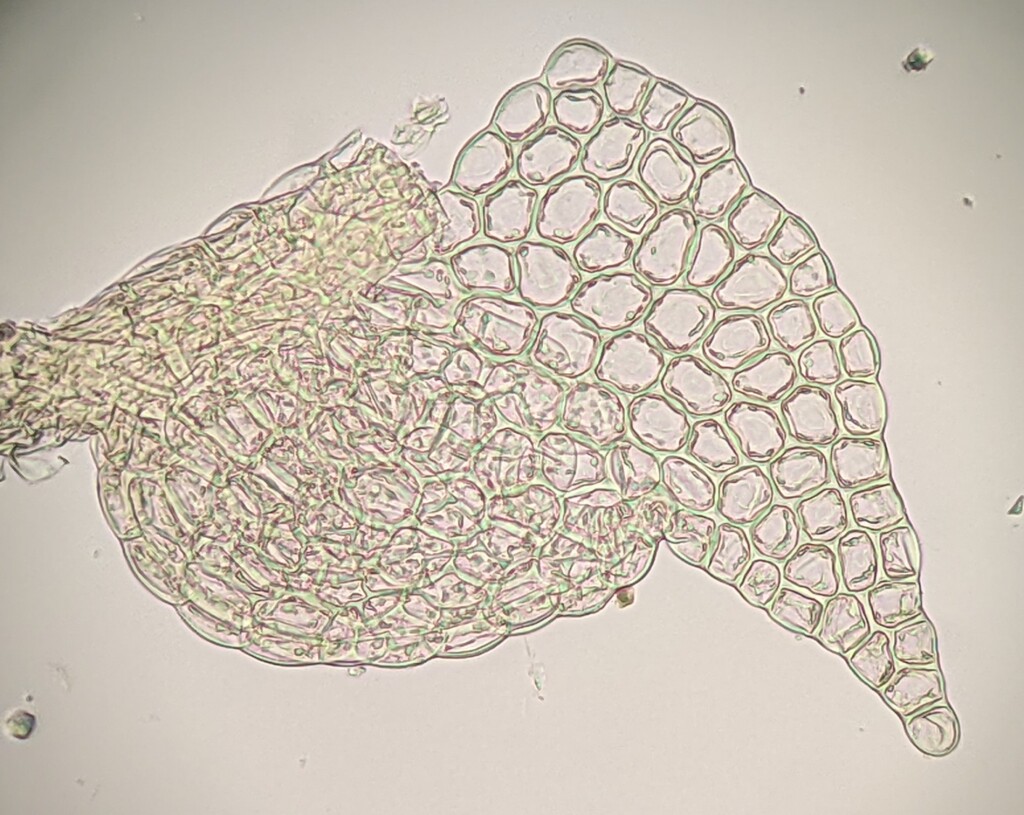Microlejeunea
Epiphytic or lithophytic (not in Victoria), monoecious (not in Victoria) or dioicous. Asexual reproduction absent. Stems irregularly branched; branches emerging from main stem near and ventral to an unmodified lateral leaf, and with a lobed and foliose collar at base. Leaves distant to imbricate (not in Victoria), spreading close to substrate, broadly attached to stem; lobe ovate (not in Victoria) to triangular, entire, rounded (not in Victoria) or acute at apex; lobule smaller than to almost equal to (not in Victoria) lobe, ovate, inflated, fused to lobe along basal margin to form an arching keel that continues curve of lobe margin (not in Victoria) or ends in a notch, free along apical margin, with 1–2 marginal teeth; tooth furthest from stem unicellular, with a marginal hyaline papilla at its base on side facing stem; cells hexagonal, pentagonal to rectangular, smooth or bulging, thin- to thick-walled, with concave-sided small trigones, with or without intermediate thickenings, with 1–5 finely segmented or granular, spherical to ellipsoid oil bodies, when 1 large and occupying most of the cell near lobe base forming ocelli. Underleaves present, one for each lateral leaf pair, V-shaped or ovate in outline and bifid with a narrow sinus (not in Victoria), rounded to cuneate at base, distant; lobes ovate-triangular, entire; cells hexagonal, pentagonal to quadrate or rectangular, smooth or bulging, thin- to thick-walled, without or with small trigones, without intermediate thickenings, without ocelli. Perianth pyriform, 5-keeled, without tubercles or teeth, with an apical beak.
Widespread in temperate to tropical region with 52 species (Söderström et al. 2016); one species in Victoria.
The sole Victorian species, M. latitans (Hook.f. & Taylor) Heinrichs, Schäf.-Verw., Pócs & S.Dong, was previously included in Harpalejeunea, but transferred to Microlejeunea because in phylogenies based on chloroplast and nuclear DNA this species is placed in a lineage among Microlejeunea species (Dong et al. 2013). Dong et al. (2013) recircumscribed Microlejeunea to encompass all species in this lineage and purport that under this circumscription Microlejeunea is distinguished from the closely related Harpalejeunea by forward directed lobes of the underleaves rather than widely divergent lobes. However, these two states are not clearly demarcated which is well demonstrated by the Victorian species that has underleaves with lobes that appear to be reasonably widely-diverging, suggesting that the two lineages that now define these two genera are largely cryptic.
Dong, S., Schäfer-Verwimp, A., Pócs, T., Feldberg, K., Czumaj, A., Schmidt, A.R., Schneider, H. & Heinrichs, J. (2013). Size doesn’t matter – recircumscription of Microlejeunea (Lejeuneaceae, Porellales) based on molecular and morphological evidence. Phytotaxa 85: 41–55.
Söderström, L., Hagborg, A., von Konrat, M., Bartholomew-Began, S., Bell, D., Briscoe, L., Brown, E., Cargill, D.C., Costa, D.P., Crandall-Stotler, B.J., Cooper, E.D., Dauphin, G., Engel, J.J., Feldberg, K., Glenny, D., Gradstein, S.R., He, X., Heinrichs, J., Hentschel, J., Ilkiu-Borges, A.L., Katagiri, T., Konstantinova, N.A., Larraín, J., Long, D.G., Nebel, M., Pócs, T., Puche, F., Reiner-Drehwald, E., Renner, M.A.M., Sass-Gyarmati, A., Schäfer-Verwimp, A., Moragues, J.S., Stotler, R.E., Sukkharak, P., Thiers, B.M., Uribe, J., Váňa, J., Villarreal, J.C., Wigginton, M., Zhang, L. & Zhu, R. (2016). World checklist of hornworts and liverworts. Phytokeys 59: 1–828.
 Spinning
Spinning